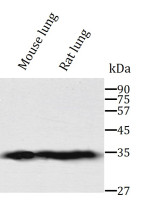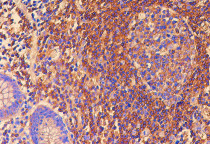ARG43685
anti-EGLN3 / PHD3 antibody
anti-EGLN3 / PHD3 antibody for IHC-Formalin-fixed paraffin-embedded sections,Immunoprecipitation,Western blot and Human,Mouse,Rat
Cancer antibody; Cell Biology and Cellular Response antibody; Gene Regulation antibody; Metabolism antibody
Overview
| Product Description | Rabbit Polyclonal antibody recognizes EGLN3 / PHD3 |
|---|---|
| Tested Reactivity | Hu, Ms, Rat |
| Tested Application | IHC-P, IP, WB |
| Host | Rabbit |
| Clonality | Polyclonal |
| Isotype | IgG |
| Target Name | EGLN3 / PHD3 |
| Antigen Species | Human |
| Immunogen | Synthetic peptide corresponding to Human EGLN3 / PHD3. |
| Conjugation | Un-conjugated |
| Protein Full Name | Prolyl hydroxylase EGLN3 |
| Alternate Names | HPH-3; HPH-1; Egl nine homolog 3; HIF-prolyl hydroxylase 3; EC 1.14.11.29; HIF-PH3; Prolyl hydroxylase domain-containing protein 3; PHD3; HIFPH3; HIFP4H3; Hypoxia-inducible factor prolyl hydroxylase 3 |
Application Instructions
| Application Suggestion |
|
||||||||
|---|---|---|---|---|---|---|---|---|---|
| Application Note | * The dilutions indicate recommended starting dilutions and the optimal dilutions or concentrations should be determined by the scientist. | ||||||||
| Observed Size | ~27-32 kDa |
Properties
| Form | Liquid |
|---|---|
| Purification | Affinity purified. |
| Buffer | 50 mM Tris-Glycine (pH 7.4), 150 mM NaCl, 0.01% Sodium azide, 40% Glycerol and 0.05% BSA. |
| Preservative | 0.01% Sodium azide |
| Stabilizer | 40% Glycerol and 0.05% BSA |
| Concentration | Batch dependent |
| Storage Instruction | For continuous use, store undiluted antibody at 2-8°C for up to a week. For long-term storage, aliquot and store at -20°C or below. Storage in frost free freezers is not recommended. Avoid repeated freeze/thaw cycles. Suggest spin the vial prior to opening. The antibody solution should be gently mixed before use. |
| Note | For laboratory research only, not for drug, diagnostic or other use. |
Bioinformation
| Database Links | |
|---|---|
| Gene Symbol | EGLN3 |
| Gene Full Name | egl-9 family hypoxia-inducible factor 3 |
| Background | Enables peptidyl-proline 4-dioxygenase activity. Involved in several processes, including activation of cysteine-type endopeptidase activity involved in apoptotic process; peptidyl-proline hydroxylation to 4-hydroxy-L-proline; and response to hypoxia. Located in cytosol and nucleus. Implicated in renal cell carcinoma. Biomarker of clear cell renal cell carcinoma. [provided by Alliance of Genome Resources, Apr 2022] |
| Function | Cellular oxygen sensor that catalyzes, under normoxic conditions, the post-translational formation of 4-hydroxyproline in hypoxia-inducible factor (HIF) alpha proteins. Hydroxylates a specific proline found in each of the oxygen-dependent degradation (ODD) domains (N-terminal, NODD, and C-terminal, CODD) of HIF1A. Also hydroxylates HIF2A. Has a preference for the CODD site for both HIF1A and HIF2A. Hydroxylation on the NODD site by EGLN3 appears to require prior hydroxylation on the CODD site. Hydroxylated HIFs are then targeted for proteasomal degradation via the von Hippel-Lindau ubiquitination complex. Under hypoxic conditions, the hydroxylation reaction is attenuated allowing HIFs to escape degradation resulting in their translocation to the nucleus, heterodimerization with HIF1B, and increased expression of hypoxy-inducible genes. EGLN3 is the most important isozyme in limiting physiological activation of HIFs (particularly HIF2A) in hypoxia. Also hydroxylates PKM in hypoxia, limiting glycolysis. Under normoxia, hydroxylates and regulates the stability of ADRB2. Regulator of cardiomyocyte and neuronal apoptosis. In cardiomyocytes, inhibits the anti-apoptotic effect of BCL2 by disrupting the BAX-BCL2 complex. In neurons, has a NGF-induced proapoptotic effect, probably through regulating CASP3 activity. Also essential for hypoxic regulation of neutrophilic inflammation. Plays a crucial role in DNA damage response (DDR) by hydroxylating TELO2, promoting its interaction with ATR which is required for activation of the ATR/CHK1/p53 pathway. Target proteins are preferencially recognized via a LXXLAP motif. [UniProt] |
| Cellular Localization | Cytoplasm; Nucleus |
| Research Area | Cancer antibody; Cell Biology and Cellular Response antibody; Gene Regulation antibody; Metabolism antibody |
| Calculated MW | 27 kDa |
| PTM | Ubl conjugation |
Images (2) Click the Picture to Zoom In
-
ARG43685 anti-EGLN3 / PHD3 antibody WB image
Western blot: Mouse lung and Rat lung stained with ARG43685 anti-EGLN3 / PHD3 antibody at 1:1000 dilution.
-
ARG43685 anti-EGLN3 / PHD3 antibody IHC-P image
Immunohistochemistry: Paraffin-embedded Human colon cancer stained with ARG43685 anti-EGLN3 / PHD3 antibody.







